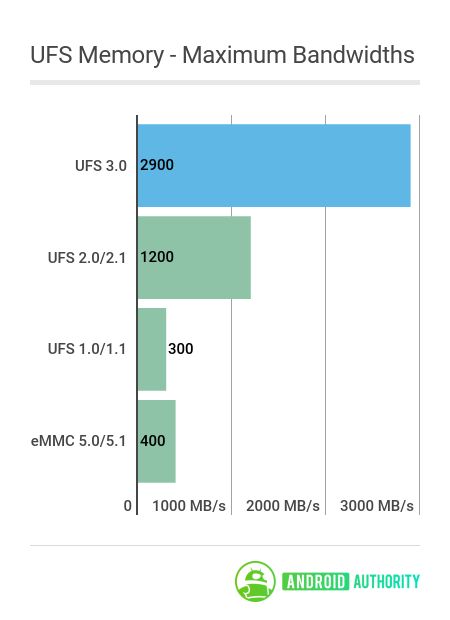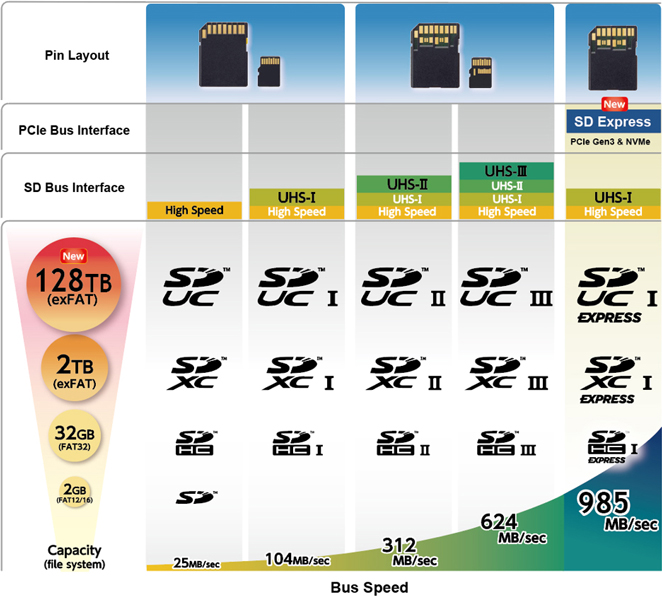
Memory technology may not be as instantly noticeable as a crisp new display or a faster processor, but it’s key for ensuring a smooth, stutter-free smartphone experience. The industry is pushing towards higher quality images and video, high-fidelity gaming, and machine learning. Memory bandwidth and capacity are under more strain than ever before.
Fortunately, new memory technologies are on the way to alleviate the strain. These include LPDDR5 RAM, UFS 3.0 internal storage, and SD Express portable memory cards. The general gist is that each of these standards will be faster than their predecessors, but let’s take a closer at the finer details and how each will help shape superior mobile experiences.
LPDDR5 RAM
RAM is an essential part of every computer, but smartphones are particularly sensitive to memory bandwidth because the CPU, GPU, and increasingly AI engines are all located on the same chip and share this memory pool. This is often a bottleneck in gaming, 4K video rendering, and other instances that require lots of reading and writing to memory.
We’re still waiting on the final specifications, but LPDDR5, just like its predecessors, is set to increase the amount of available bandwidth and improve energy efficiency once more. LPDDR5 bandwidth is expected to hit at least 6400 Mbps, doubling the 3200 Mbps that LPDDR4 shipped with. Although, subsequent revisions have seen LPDDR4 and 4X able to hit up to 4266 Mbps.
According to IC design company Synopsys, LPDDR5 introduces a dual differential clock system using a WCK clock similar to that found in fast GDDR5 graphics memory. Differential clocking increases the frequency without upping the pin count and these two clock implementations (WCK_t and WCK_c) allow for two different operating points at either double or quadruple the command/address clock. LPDDR5 will also support Link ECC functionality for Read and Write operations, allowing it to recover data from transmission errors or due to storage charge loss.
Better still, the standard is still focusing on energy efficiency — a key requirement for mobile products — with a lower operating voltage. Deep Sleep Mode is also implemented to reduce current by up to 40 percent when either in an idle or self-refresh state. Data Copy Low Power also reduces power by utilizing repeating data patterns for normal Write, Mask Write, and Read operations, so the higher performance point shouldn’t drain any more of our precious battery life.
We’re still waiting on manufacturers to announce their first LPDDR5 memory chips. Samsung murmured some plans to accelerate commercialization late last year and rumor suggests that production could start in the second half of 2018. Either way, we aren’t expecting to see our first phones boasting the technology until 2019 at the very earliest.

UFS 3.0 ROM
Fast storage is just as important as fast RAM these days, especially if you want to read and store high-resolution video or load up high-quality assets for AR and VR. UFS is quickly replacing eMMC as the memory standard of choice in smartphones. JDEC has already published the official UFS 3.0 specification for its next-gen memory, giving us a look at the performance and power improvements heading to future high-end mobile device storage.
The headline improvement is that speeds have doubled from UFS 2.0 found in some of today’s high-end devices. Each lane can handle up to 11.6 Gbps of data, up from 5.8 Gbps, which gives a peak transfer speed of a whopping 23.2 Gbps. That said, real speeds will be a bit lower than this theoretical maximum. Fortunately, all UFS 3.0-compatible devices are required to support HS-G4 (11.6 Gbps) and HS-G3 (5.8 Gbps), so they’ll definitely be faster than all versions of UFS 2.0.

The standard’s power consumption has changed too. There are now three power rails, 1.2V, 1.8V, and 2.5V/3.3V, and the introduction of 2.5V on the VCC line will help support upcoming higher density 3D NAND flash designs and lower power consumption. In other words, UFS 3.0 is designed to support larger storage sizes, which will be available with upcoming manufacturing techniques.
Just like LPDDR5, Samsung looks set to be one of the first to offer UFS 3.0 storage. Manufacturing for automotive applications has already begun, so a product suitable for smartphone use probably isn’t too far away either. The technology will likely hit the mainstream in 2019.

SD Express portable storage
Finally, we come to portable storage, a sought-after feature in smartphones for moving large media libraries between devices. The newly unveiled SD Express standard will likely replace future microSD cards, although fast UFS memory cards remain a possibility too. In a nutshell, SD Express boasts the fastest ever SD card speeds and support to use them as portable SSDs.
SD Express incorporates PCI Express and NVMe interfaces into the legacy SD interface, two common data bus standards found across the PC space. These interfaces will be supported on the second row of pins that are already used by highspeed UHS-II microSD cards on the market today.
Supporting PCI-E 3.0 with SD Express means peak throughput can hit a whopping 985MB/s, which is more than three times faster than UHS-II cards which top out at 312MB/s and even faster than UHS-III cards that support up to 624MB/s. Meanwhile, NVMe v1.3 is the industry standard used for solid state drives (SSDs), which means that upcoming SD cards will be able to serve as removable SSDs for plug and play access to large amounts of data, software, and even operating systems.
In addition to supporting higher speed memory interfaces, the maximum storage capacity of future microSD cards is set to increase from 2TB with SDXC to 128TB with the new SD Ultra-Capacity (SDUC) cards.
SD Express is backward compatible with existing microSD cards and ports, but you’ll be limited to the lower speeds. So a UHS-I device will be capped at 104MB/s, even with an SD Express card. Unfortunately, there are a few compatibility issues with newer card types too that will cap speeds, as a UHS-II or UHS-III card will revert to UHS-I speeds in an SD Express host because the pins are repurposed.
Wrap up
Memory improvements are heading our way across the board, catering for faster and higher capacity internal memory, RAM, and portable storage. At first, these latest technologies will command a premium, as usual, so we’ll certainly see them appear in flagship-tier smartphones first, before trickling down to more cost-effective price points the following year or so.
Each of these faster memory technologies will likely break through into flagship smartphones in 2019, although it’s possible we might see a phone or two adopt one of these features a little sooner than the pack. We’ll just have to sit tight until memory manufacturers announce the actual chips that will end up in products.
from Android Authority https://ift.tt/2MCm7Ju



No comments:
Post a Comment